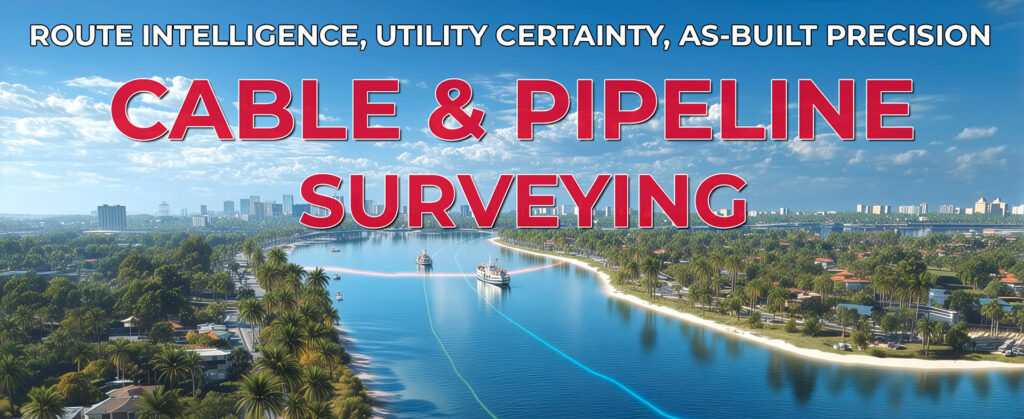Owners, EPC teams, and marine contractors progress fastest when every meter of corridor is mapped, every crossing is known, and every burial depth is documented. Cable and pipeline surveying delivers that clarity. ARC Surveying and Mapping integrates high‑resolution multibeam swath sonar, side‑scan sonar, sub-bottom surveys, RTK GPS positioning, magnetometer passes, and synchronized data collection to turn complex seabed corridors into decision‑ready maps and models.
What comprehensive route intelligence looks like
Multibeam swath coverage. Continuous bathymetry across the proposed corridor reveals gradients, depressions, and bedforms that matter for trenching and stability. Groton–Fisher Island and Plum Island–Orient Point route surveys used high‑resolution multibeam tied to RTK GPS control for precise positioning and real‑time visualization of the seafloor.
Side‑scan sonar imagery. Once multibeam defines the corridor surface, side‑scan imagery elevates object detection. On the same Groton and Plum Island surveys, side‑scan enhanced the visibility of targets such as previously laid utilities and debris, supporting confident routing.
Magnetometer tracking. Magnetic anomaly lines add a signature for ferrous utilities and armor wire. During the Freeport Harbour utility sweep, magnetometer passes tied to harbor control located active and legacy services along the berth face and set the stage for safe bulkhead design.
Laser scanning where structures meet water. Topographic laser scans integrate shoreline, bridge, and berth geometry with hydrographic results. The Escambia County Bridge program combined a topographic laser scan with high‑definition multibeam sounding and documented a utility crossing identified during the bridge survey.
Navigation and acquisition discipline. Installation campaigns benefit from instrumented guidance. At Toms River, a remote RTK GPS system mounted on both the cable plow and the barge, guided by HYPACK navigation and data collection software, delivered precise headings and positions during lay. Continuous logging produced as‑built drawings with burial depths for six high‑voltage cables along two routes of approximately two miles each.
Together, these layers create route certainty during planning, precision during installation, and trustworthy records after completion.
From survey to engineering decision
- Pre‑installation investigations establish a clear corridor. Groton and Plum Island route studies mapped 16,000 by 1,000 feet and 4,000 by 300 feet respectively, giving planners a complete understanding of depths and seafloor features along multiple alignments. The combined multibeam and side‑scan dataset supported selection of a path with favorable conditions and efficient constructability.
- Installation guidance integrates navigation with measurement. The Toms River approach linked RTK GPS on the plow and barge through HYPACK so headings, offsets, and turning points remained consistent with the engineered plan while the system logged the cable’s position and burial continuously.
- As‑built verification closes the loop. Continuous records and targeted checks generate drawings that show the position and burial depth for each circuit, enabling operations teams to manage crossings and future maintenance with confidence.
Four project snapshots that illustrate the range
Cable Route Investigative Surveys, Groton CT to Fisher Island and Plum Island to Orient Point NY. High‑resolution multibeam swath mapping with RTK GPS positioning covered two corridors measuring 16,000 by 1,000 feet and 4,000 by 300 feet. Side‑scan imagery enhanced object visibility, including legacy utilities. The combined dataset supported selection of an optimal path across variable seabed conditions.
Freeport Harbour Utility Sweep, Grand Bahama Island. New bulkhead construction required certainty about active and abandoned utilities. Multibeam lines, side‑scan imagery, and magnetometer passes tied to harbor control were plotted in 3D. Design teams placed sheets and tiebacks with confidence, and the expansion program maintained schedule continuity.
Toms River Multichannel Cable Crossing, New Jersey. A remote RTK GPS system was mounted on both cable plow and barge, and HYPACK guided navigation and logging during installation. As‑built drawings documented location and burial depth for six high‑voltage power cables along two routes of approximately two miles each.
Escambia County Bridge, Cable Locate integrated with Bridge Survey. A shoreline and bridge laser scan combined with high‑definition multibeam swath sounding created a comprehensive model focused on scour and utility presence. The program documented a cable crossing within the survey reach, adding valuable context for bridge assessments.
Why this approach serves owners, EPCs, and operators
- Route clarity for design through multibeam and side‑scan correlation that highlights obstructions, seabed texture, and potential crossing points.
- Utility certainty for construction using magnetometer targets plotted in 3D so sheets, tiebacks, or trenchers align safely with existing services.
- As‑built precision for operations with RTK GPS and HYPACK logs that produce burial‑depth drawings suited for asset management and future crossings.
Every phase benefits from a single georeferenced frame that aligns planners, builders, and owners.
How technology choices shape superior results
ARC Surveying and Mapping selects instruments for their contribution to a unified route model. Multibeam delivers continuous depth control, side‑scan adds high‑definition object imagery, magnetometer tracking pinpoints ferrous utilities, and laser scanning captures the above‑water structures that interface with marine corridors. When installation begins, RTK GPS on both lay vessel and plow, integrated through HYPACK, keeps guidance and documentation synchronized. Targets and tracks are then plotted in 3D for rapid review by engineers and construction teams.
Cable and pipeline corridors thrive on precise mapping, smart guidance, and authoritative records. The Groton and Plum Island route investigations, the Freeport Harbour utility sweep, the Toms River multichannel crossing, and the Escambia County Bridge survey demonstrate a consistent method: plan with full‑coverage datasets, build with instrumented navigation, and deliver as‑builts that stand up to future work. ARC Surveying and Mapping provides the integrated measurements and models that keep flows protected and projects moving.

